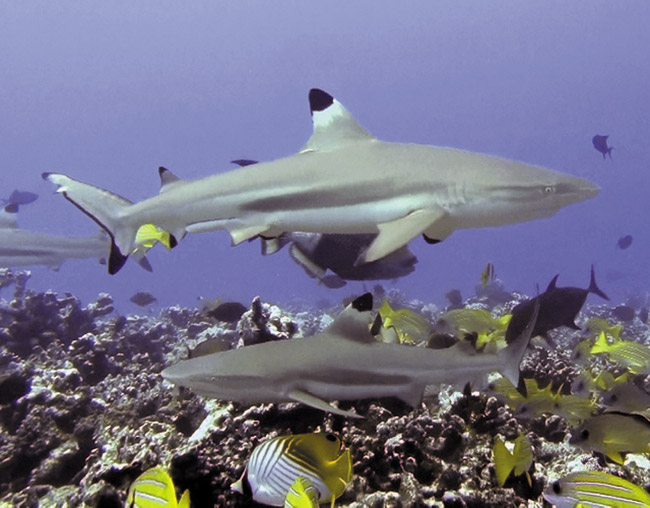A Shark Fishery In Hawaii?
After seeing my column “Reasons For All The Shark Attacks” last week, an anonymous MidWeek reader sent me this email:
“Just got back from Maui and a guy from Kihei told me that the rumor over there is that the aquarium raises tiger sharks, but can only keep them to a certain size and then they release them into the ocean. These are sharks that are used to humans and being fed by them.”
Since the email sender didn’t specify which aquarium, I called Andrew Rossiter, Ph.D., director of the Waikiki Aquarium.
“We haven’t had any tigers here in at least 20 years,” he said. “When we do have a shark get too big, we usually donate it to the Pacific Beach Hotel” for the Oceanarium restaurant’s big tank.
I also called Kate Zolezzi, general manager of the Maui Ocean Center at Kihei.
“Maui Ocean Center, The Hawaiian Aquarium does house juvenile tiger sharks from time to time,” she says. “We believe that because of their importance in the ocean eco-system as well as their cultural significance in Hawaii this offers important educational value. The average length of time a juvenile tiger shark would be housed at Maui Ocean Center is approximately six to nine months. They are then released back into the open ocean to continue their life cycle. MOC educates on a daily basis our visitors, residents, members and school children on ocean safety issues and stresses the importance of following DLNR and Maui safety guidelines to avoid shark/human encounters in the ocean.”
That seems reasonable. It’s not like they’re being hand-fed like baby parrots.
I also want to clarify my comment about legalizing shark fishing. What I should have said was Hawaii might consider creating a commercial shark fishery, including finding some beneficial uses of sharks. And as John Naughton said in the column last week, “the whole shark.”
But as Andrew Rossister explained, “Sharks aren’t very tasty.”
The only real value, he said, would be the fins, and it is illegal to possess a shark fin in Hawaii. If longliners pull in a shark as by-catch, “they usually just cut that line free.”
The irony is that shark fins are said to be tasteless, and are used as a soup thickening agent. Isn’t that why God created cornstarch?
From what I could find, there are shark by-products, including shark liver oil, which contains “squalene.” It is used in a number of beauty and anti-aging products, as well as Preparation H. These are generally deep-water sharks (as opposed to Hawaii’s tigers), whose livers can account for up to 30 percent of body weight. But overfishing has depleted many of these shark species, especially in the Atlantic – too bad because it’s said a better form of squalene is available from olives.
That is not true of the growing market for luxury products made of sharkskin leather.
But back to last week’s column. We know why there have been more shark attacks on humans this year than in any other on record: more sharks and more people in the water doing more ocean activities.
The question is do we want to live with this new “normal,” where every swim, snorkel, scuba or surf session involves a bigger and very real risk of life and limb, literally, than we’ve ever known?
For some people, the answer is no. Terry Lilley of Kauai, who I quoted last week and published one of his shark photos, disagrees:
“We need more sharks, not less.
“Do you know that a healthy reef has one big shark every 100 yards? There is a reason for this. The sharks eat all the dead stuff and keep the fish populations healthy. Without a good shark population, the reef dies.
“More shark bites just mean more people in the shark’s habitat. More sharks is good, not bad. We must increase our shark population, not kill them for any reason. I surf or dive almost every day with or near big sharks, and if I get bit, so be it. It is my risk playing in their home!”
Terry shot the accompanying photo at Moorea a few weeks ago.
“I was in the middle of 30 sharks in a feeding frenzy,” Terry explains. “It was awesome, but I could have been bit. If that happens, protect the shark that bites me.”
I wonder how many ocean lovers feel the same.
dchapman@midweek.com






